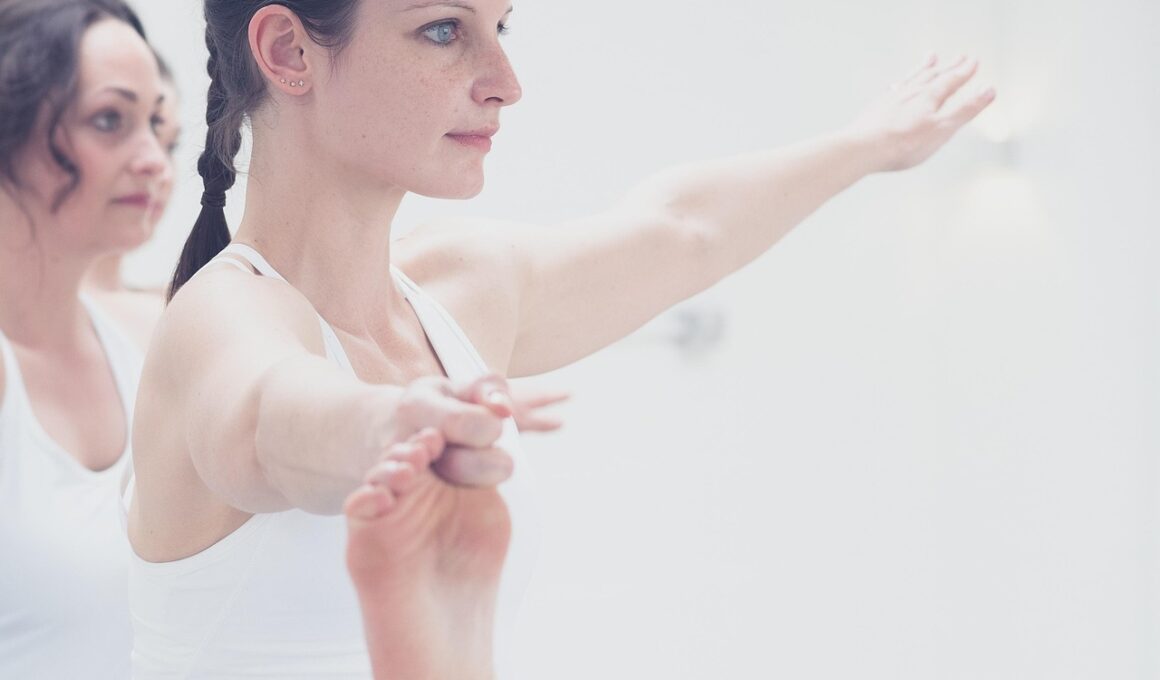Top 10 Gym Workouts to Improve Your Flexibility
Improving flexibility is essential for overall fitness and injury prevention. Incorporating specific gym workouts into your routine can significantly enhance your flexibility. Here are ten effective workouts that target various muscle groups, helping improve your flexibility. Start each session with a warm-up to prepare your body. Dynamic stretches are ideal for getting your muscles ready for more intense flexibility exercises. Incorporating flexibility training not only helps with muscle elasticity but also enhances athletic performance. Additionally, improved flexibility can alleviate muscle tension and enhance joint health. Always focus on your breathing while performing flexibility exercises. Deep, controlled breaths help promote relaxation and improve stretch depth. Stand in front of mirrors when practicing your flexibility workouts. This allows you to check your form and ensure you are performing exercises correctly. Remember to listen to your body and avoid pushing yourself beyond your limits. Gradually increase the intensity and duration of your workouts over time. Regular stretching leads to lasting benefits in flexibility, creating a more functional and agile body. Aim to incorporate these workouts into your regular gym sessions for optimal results. Now, let’s explore each exercise in depth.
1. Standing Quad Stretch: This exercise targets the quadriceps and hip flexors. Stand on one leg, grabbing the ankle of the opposite leg and pulling it towards your buttocks. Ensure your knees stay close together, feeling the stretch in the front of your thigh. Hold this position for about 30 seconds, focusing on steady breathing. Switch legs and repeat. 2. Seated Hamstring Stretch: Sit on the ground with one leg extended and the other bent. Reach towards your toes on the extended leg, feeling the stretch in your hamstring. Hold for 30 seconds, then switch legs. 3. Butterfly Stretch: Sit on the floor and bring the soles of your feet together. Gently push your knees toward the ground to stretch your inner thighs. Hold this position for about 30 seconds, breathing deeply. 4. Pigeon Pose: Start in a plank position, bringing one knee towards your hand while extending the other leg back. This stretch deeply targets your glutes and hips. This can be intense, so listen to your body.
5. Cobra Stretch: Lie on your stomach, placing your hands under your shoulders. Push your upper body off the ground, stretching your abdominal area and lower back. This work is crucial for spinal flexibility and can help alleviate back tension. Hold for 15 to 30 seconds. 6. Incline Forward Bend: Stand with your feet shoulder-width apart and slowly bend forward at your hips. Try to touch your toes while keeping your knees slightly bent. This exercise targets your hamstrings and lower back, promoting flexibility throughout your posterior chain. Hold this position for about 30 seconds while breathing deeply. 7. Side Lunge Stretch: Step out to the side, bending one knee while keeping the other leg straight. This stretch targets your inner thighs and hip flexors. Hold for 15 seconds, switch sides, and repeat. 8. Overhead Side Stretch: Stand tall and reach one arm overhead while leaning to the opposite side. This stretches your obliques and increases lateral flexibility, which is crucial for overall movement patterns.
9. Wall Calf Stretch: Step back and place your hands on a wall while keeping one leg behind you straight and the other bent. Feel the stretch in your calf muscles. Hold for 30 seconds before switching sides. 10. Foam Roller Stretching: Incorporate foam rolling into your routine. This method helps release tight muscles and improves flexibility. Roll over each muscle group for 30 seconds, focusing on areas of tightness to promote blood flow and elasticity. Consider interspersing passive stretching with active flexibility work to achieve better results. Other tips include maintaining hydration and practicing yoga, which enhances both flexibility and mental well-being. Include both static and dynamic stretches for a balanced approach. The combination of strength training and stretching can greatly improve your flexibility over time. Remember to be patient, as flexibility improvements take time and consistent practice. Ultimately, regularly incorporating these gym workouts into your routine, combined with a focus on proper nutrition, will lead to superior flexibility.
Maintaining consistency in your flexibility workouts is essential for long-term success. Schedule dedicated training sessions to focus on these exercises. Flexibility is not just about performing a single stretch once; it’s about integrating it into your weekly workout regime. Consider tracking your progress with photographs or flexibility assessments to see improvements over time. It can be motivating to see how far you’ve come. Additionally, don’t hesitate to consult with a trainer if you feel unsure about your techniques. Personal trainers can provide valuable insights and adjustments to enhance your workout quality. You may also want to incorporate elements like pilates and yoga, which focus heavily on flexibility and strength simultaneously. Beyond gym workouts, consider practicing flexibility routines at home to boost your gains and commitment. Many online resources offer guided sessions to help you enhance flexibility and strength effectively. Your body will appreciate the added care, promoting overall wellness. As you become more flexible, you will likely notice improvements in your performance across various physical activities. This transformation showcases how flexibility workouts are essential for a balanced fitness approach. Embrace your flexibility journey and enjoy the benefits that come with improved mobility.
Conclusion
In conclusion, incorporating flexibility workouts into your gym routine can significantly enhance overall fitness. Transition from day-to-day strains to an agile, nimble body. By committing to these workouts, you can improve athletic performance, prevent injuries, and enhance overall health. Use the exercises discussed to create a targeted flexibility program tailored to your goals. Remember that everyone’s flexibility journey is unique; progress may vary. Your dedication will pay off, and you will encounter newfound ease in your movements daily. Flexibility workouts create space for growth, strength, and increased range of motion. This encourages you not just to stretch physically but to adopt an expansive mindset towards fitness and health. Work towards incorporating these exercises into a larger fitness routine that balances strength, cardio, and flexibility. The regular practice of stretching will provide you with long-lasting physical benefits and enhance your quality of life. Celebrate your progress and remain open to challenging your body as well. With perseverance and dedication, you will transform your flexibility, enjoying the many advantages that come from it. Commit to this continued growth, and watch as your efforts reflect in your overall physical prowess.
Now, take these lessons and apply them in your gym sessions regularly. Consistency is key for adaptability and growth. By doing so, you not only improve your flexibility but also cultivate a deeper understanding of your body and its capabilities. Understanding how your body moves and reacts during these workouts is necessary for maximizing benefits. Ensure to integrate rest days into your flexibility training schedule to give muscles time to recover and grow. A well-rounded training regimen that includes mobility, strength, and flexibility work will have a transformative effect on your overall fitness journey. By adopting such a holistic approach, you’ll experience balanced muscle development, improved performance, and reduced risk of injuries. Your body can be a resilient machine with the right care and training. As you progress, you may wish to explore advanced flexibility techniques or styles such as aerial yoga, which adds another layer of challenge to your routine. Stay motivated and enjoy the process; flexibility training can be both challenging and rewarding. Continually seek out new ideas, workouts, and techniques that can keep your training fresh and enjoyable. Develop a long-term approach to improve your flexibility, embrace the journey, and celebrate every achievement along the way.
To summarize, flexibility workouts in the gym play an instrumental role in an effective exercise routine. Investing in these exercises fosters overall strength and health, allowing for graceful movements in various activities. Whether you’re an athlete or just looking to enhance daily activities, focusing on flexibility will serve you well. With structured practice and the exercises outlined, you will systematically improve your flexibility. Gratifyingly recognize your progress over time while pushing for more significant gains. Flexibility isn’t merely an aspect of fitness; it enriches your entire experience, allowing for enjoyment in physical activities like sports, dance, or even simple daily tasks. Additionally, coupling your flexibility workouts with strength training offers comprehensive benefits. You’ll find that you can perform more athletic moves, decrease potential injury risks, and recover faster after workouts. It all ties together to create a well-rounded fitness experience. Challenges may arise, but it’s important to stay committed to your flexibility goals. Resolute dedication leads to lasting changes, both physically and mentally. It brings about the resilience needed to adapt and excel in your fitness journey. Through consistency, self-awareness, and an open mind, the drive to improve your flexibility will truly enhance your life.


